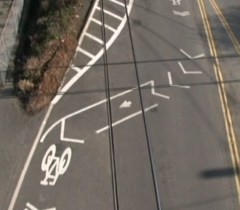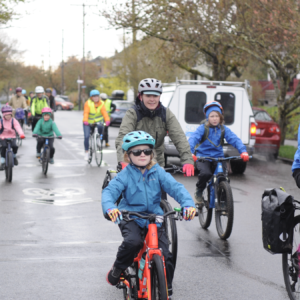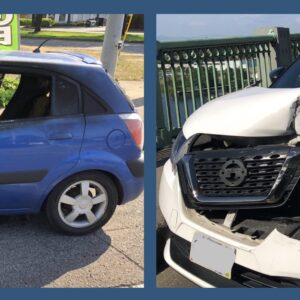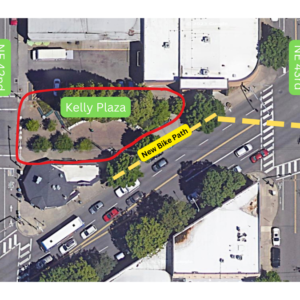
showing Seattle’s track treatment.
Streetfilms’ latest video comes from our neighbors to the north in Seattle. The film takes a closer look at how the Seattle DOT is helping people who ride bicycles avoid a common problem — falling on streetcar and rail tracks.
The film features John Mauro from Seattle’s non-profit bike group Cascade (he narrates the short video below). Here’s a quote from the film that stood out to me (watch the vid below the jump):
“The Seattle DOT has taken a pedal-by-pedal approach to getting people across the cross by taking sharrows and marking every couple feet of the cyclist’s path.”
With all the streetcar and MAX light rail expansions going on in Portland, this is going to be an issue that local bike planners will be faced with well into the future. PBOT already does something similar to this, although less aggressive in design, at streetcar tracks on NW Lovejoy and 11th and on N. Interstate at the entrance to the Steel Bridge. In other places, they rely on cute signs like this.







Thanks for reading.
BikePortland has served this community with independent community journalism since 2005. We rely on subscriptions from readers like you to survive. Your financial support is vital in keeping this valuable resource alive and well.
Please subscribe today to strengthen and expand our work.
It’s important to note that this SDOT response was to, as the Cascade Bike Club guy says, approximately 60 reported crashes at one particular rail crossing.
It does not reflect normal SDOT response to the many places around town with oblique rail crossings (and there are newly installed crossing here for street cars, light rail and heavy industrial more and more every year).
Their normal response is more of a “Hmmm, really, gosh, oops maybe we shoud have thought of that….”
So many people have unreasonable fears of tracks. Not sure if this comes from a bad fall or what. Otherwise good riders will sometimes do everything possible to only cross tracks at exactly 90 degrees, even if that means veering into traffic without looking. Huh?
Please please please practice simple unweighting of the wheels (especially the front wheel) and you will be shocked at what you can ride over with no danger.
Beginners of course will need help understanding this maneuver, but it should be a standard part of any cycling safety information, right up there with “don’t ride on the sidewalk”.
Difficult to see steel plates or covers on wet turns are a heck of a lot more dangerous, in my opinion.
I’m curious to know how many people ride down SW 10th Avenue downtown. I take the right side of the road out of habit, right where the tracks run parallel on 10th. My wife and I rode down one day and while keeping an eye on her to make sure she didn’t crash, I bit it pretty good. User error of course, but I haven’t ridden on 10th since.
I ride 10th fairly regularly. Sometimes I ride between the tracks, out of habit, sometimes I ride in the left lane.
I’ve heard of this idea before: why is there not some kind of dense rubber in the tracks that a 200 pound cyclist can cruise over but a multi-ton max train depresses to stay on track? reminder: I’m not an engineer.
I believe there is a similar treatment here in town on SW Moody heading into S waterfront when crossing the tracks in front of OHSU. It works great, but I find most people don’t even bother to follow it.
There’s a convoluted perpendicular route to cross the Max Yellow Line up by the Dancin’ Bare as well. I’ve never taken it, however. I always take the lane and cross the track carefully.
The ONLY reason that SDOT even made this change was the repeated nature of the accidents. What’s not obvious is that the city’s “premier” trail (Burke-Gilman) ends in a cluster-F a few blocks west of here and many recreational (and commuters – but they were involved in fewer accidents) cyclists continued after its end and on to either the business district of Ballard or Golden Gardens Park. Add to that a multi-year negotiation w/ the city to extend the BG trail, and they figured they oughta do something.
In about 3 months the paint will have been worn away and we’ll be back to square one. Seattle doesn’t “do” maintenance.
w.r.t. the idea of a rubber material – I am of the same opinion (and an engineer). There’s a spot about 1 mile east of this photo that has just such a rubbery matt. The problem is that they made the entire surface between the tracks and on about a foot on either side of the tracks of the same material. And when it’s cold enough, the stuff turns into an extremely low friction surface. Right where you have to turn!! Ingenious. I see 6-10 accidents there every year on my commute.
Evan–
The official reason we don’t use the rubber flanges is because they’re expensive and wear out quickly. I also heard they can lead to derailment.
I’d love to see the rubber used at some of the more problematic spots. Chicago has used it on one of their train/bike/ped bridges, but it’s very low traffic on the train side. We’re asking for trouble if we don’t solve this conflict.
I bit it at that very spot a couple of years ago, on a group ride where I let myself get boxed in.
the more ridiculous SDOT and tracks interaction is the whole of the trolley system, where they made the easiest path into downtown have the streetcar tracks in the right lane, and then were “shocked” when people started crashing there.
I love these markings.
Aside from RR tracks…
I can totally see similar sharrows crossing those “Jogs” like on Powell at 42nd, and Holgate at 42nd.
A little visual for motorists to know bikes cross, and cyclists can have a clear understanding of the crossing.
A bike signal and these sharrows… we have a much safer crossing in the East.
Nick V: I always take the left/middle lane on 10th. In fact, I always take the middle/left lane when biking downtown on a street with no bike lane.
I was going to make the point that several others already had. I hope that less experienced cyclists remember to look behind them before making the “snake” route to cross the tracks here. However, I have heard positive things about the new markings.
SDOT is planning on installing a similar snake crossing on the streetcar tracks from 7th crossing Westlake. That’ll be a little trikier because those cyclists will be riding in heavier traffic – I’m hoping that the pavement markings there will be obvious to drivers so they expect cyclists to ride seemingly erratically.
About the rubber – I cross I don’t know how many tracks on my commute and there’s only one location, on Alaskan near Atlantic where there’s a rubber type track guard installed. It’s fantastic. It’s been there for at least 3 years now and still looks new, in spite of heavy auto and 18-wheeler traffic.
I’d like to see markings such as those on SW 5th Ave in Beaverton, where 3 sets of tracks cross the road, all at bad angles.
Also key to note: is if the tracks are sitting high in some spots, no matter how you cross they are slick. 🙂
The other thing for safe track crossing is to have your bike perpendicular to the ground — no leaning.
The model in Clarence’s video has his bike tilted to the right when the front wheel goes over the first track, and to the left when the rear wheel goes over the far track. This is a no-no of you want to be in 100% control. He needs to either slow down and bank less into the turn, or get the city to widen the approach curves.
Another way to think about it — imagine doing a U Turn at that location (instead of an S Turn). Your bike will be banked into the turn, and when you hit those rails, even if you it them at 90 degrees, you’re going to have serious slippage and may go down if the rails are wet.
Portlanders will soon have this problem when they put the rails at Broadway/Lovejoy on the bridge. Southbound bicyclists will cross those rails at a right angle as they go south onto Broadway, but they’ll be banked inward to make the curve (and the rails will be sloped downward!) and there will be a lot of serious crashes by the uninitiated.
(This could be partially mitigated by installing highly textured pavement on both sides of both rails — so even if you slip outward on the rail, there will be enough knobby bits in the adjacent pavement to keep you from going into a full slide, even if it’s wet).
Ted Buehler
Regarding someone’s earlier question about biking down NW 10th. It used to be part of my regular commute (I changed my route, but not because of the tracks). I used to go down the center of the lane, between the tracks. There is not enough room to be between the right side of the tracks and stay safely out of the door zone and the streetcar curb extensions.
When I needed to make my right at Everett, I would signal early and slow way way down to make that right across the tracks very carefully. I found that the tracks were extra slippery in the rain and it was only in the rain that I stuffed my tire in the track once (luckily it was rear tire and it was an easy recovery). Attempting to take the left lane (perfectly legal on this one way street) made it too hairy to cross over the tracks as part of a lane change in preparing to make a right turn. It was just easiest to stay in the right lane between the tracks.
Used to ride down 10th every day. One day, the tracks ate my wheels. I ended up deaf in one ear for over a month and gained some more road rash scars and a small ache in my right elbow.
I never used to be afraid of the tracks. These days, my heart speeds up whenever I cross them at anything but a 90 degree angle. I truly hate them.